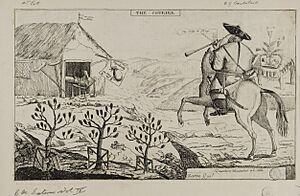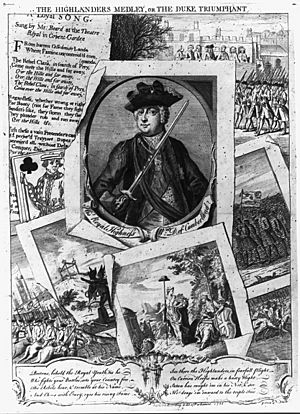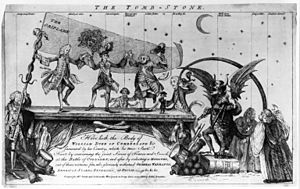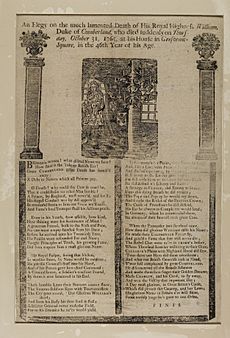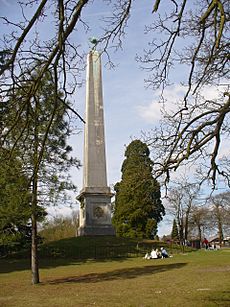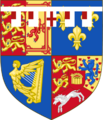Prince William, Duke of Cumberland facts for kids
Quick facts for kids Prince William |
|||||
|---|---|---|---|---|---|
| Duke of Cumberland | |||||
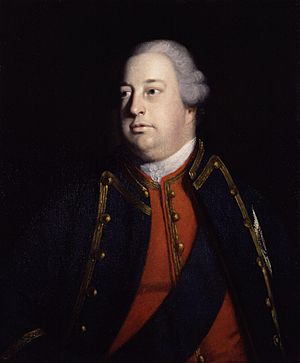
The Duke of Cumberland by Sir Joshua Reynolds, c. 1759
|
|||||
| Born | 15 April 1721 (New Style) Leicester House, London, England |
||||
| Died | 31 October 1765 (aged 44) Mayfair, London, England |
||||
| Burial | 10 November 1765 Westminster Abbey, London |
||||
|
|||||
| House | Hanover | ||||
| Father | George II of Great Britain | ||||
| Mother | Caroline of Ansbach | ||||
| Military career | |||||
| Nickname(s) | The Butcher Sweet William Martial boy |
||||
| Allegiance | |||||
| Service/ |
|||||
| Years of service | 1740–1757 | ||||
| Rank | General | ||||
| Unit | Grenadier Guards | ||||
| Commands held | Pragmatic Army Government Army Hanoverian Army of Observation Commander-in-Chief of the Forces |
||||
| Battles/wars | |||||
Prince William Augustus, Duke of Cumberland (born April 15, 1721 – died October 31, 1765) was a British prince. He was the youngest son of King George II and Caroline of Ansbach. From 1726, he was known as the Duke of Cumberland.
He is most famous for stopping the Jacobite Rising at the Battle of Culloden in 1746. This made him very popular in some parts of Britain. However, his opponents called him 'Butcher' Cumberland' because of his harsh actions after the battle.
During the War of the Austrian Succession, William led the main British army in Europe. He tried to defend the Austrian Netherlands and the Dutch Republic. After 1757, he stopped active military command. He then focused on politics and horse racing.
Contents
Early Life of Prince William
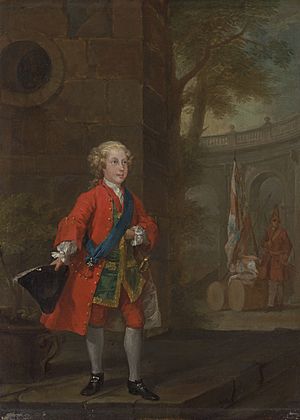
William was born in Leicester House, London. His parents had moved there after his grandfather, George I, became King of Britain.
When he was only five years old, on July 27, 1726, he received many titles. He became the Duke of Cumberland, Marquess of Berkhamstead, Earl of Kennington, Viscount of Trematon, and Baron of the Isle of Alderney.
The young prince received a good education. His mother hired famous people like Edmond Halley as his tutors.
Early Military Career
From a young age, William showed he was brave and capable. He became a favorite of his parents. At age four, he joined the 2nd Foot Guards. He was also made a Knight of the Bath.
His parents wanted him to become the Lord High Admiral of the Navy. In 1740, he sailed as a volunteer with the fleet. But he soon decided he didn't like the Navy. Instead, he became a colonel in the Grenadier Guards in 1741.
War of the Austrian Succession
In December 1742, William became a major-general. The next year, he fought in his first battle in Germany. King George II and William fought together at the Battle of Dettingen on June 27, 1743. William was wounded in his right leg during this battle. After the battle, he was promoted to lieutenant general.
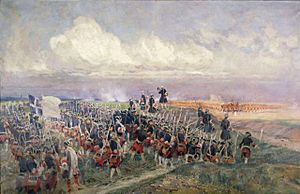
In 1745, William was made Captain-General of the British land forces. He became the leader of the allied British, Hanoverian, Austrian, and Dutch troops in Flanders. This army was known as the Pragmatic Army. He was quite inexperienced for such a big role.
William first wanted to attack the French and capture Paris. But his advisors told him this was not possible. The French army was much larger.
The French planned to take Tournai. William moved his army to help the town. The French Marshal Maurice de Saxe had surrounded Tournai. On May 11, 1745, William's forces fought the French at the Battle of Fontenoy. The Allies were defeated. Marshal Saxe had chosen the battlefield and hidden French marksmen in nearby woods. William ignored the danger from these woods. He focused on taking the village of Fontenoy and attacking the main French army.
The British and Hanoverian troops attacked the French center very well. Many thought the Allies had won. But they failed to clear the woods. Also, the Dutch forces could not capture Fontenoy. This forced William to retreat to Brussels. He could not stop the French from taking Ghent, Bruges, and Ostend. William was often criticized for his battle plans, especially for not taking control of the woods.
Jacobite Rebellion: The Forty-Five
William was chosen to stop Prince Charles Edward Stuart. Charles was trying to take back the throne for his family, the Stuarts. This event is known as the Jacobite rising of 1745. William's appointment was popular. It made people and soldiers loyal to King George feel more confident.
William returned from Flanders to prepare to stop the Jacobite uprising. The Jacobite army had moved south into England. They hoped English Jacobites would join them. But they got little support. Charles's followers decided to go back to Scotland.
William joined the army in the Midlands. He began to chase the Jacobites as they retreated north from Derby. In December 1745, a part of his army was pushed back at Clifton Moor. William realized it would be hard to catch the retreating Highlanders. He retook Carlisle. Then he was called back to London. There were fears of a French invasion.
His replacement as commander, Henry Hawley, was defeated at Falkirk Muir in January 1746. This caused great panic in England.
The Battle of Culloden
William arrived in Edinburgh on January 30, 1746. He took command of his forces. He marched them to Aberdeen. There, he ordered them to train for about two months. This was to get ready to fight the Jacobite Army.
On April 8, he left Aberdeen with his troops for Inverness. Eight days later, on April 16, he fought the main Jacobite army near the village of Culloden. In the battle, his army completely defeated the Jacobites. The battle lasted only an hour. The Jacobites had between 1,500 and 2,000 casualties. About 300 government soldiers were killed or wounded.
The morning after the battle, William gave a written order. He reminded his men that the rebels' orders were to "give us no quarter" (meaning, no mercy). He ordered his men to treat wounded Jacobites the same way. William said such orders were found on dead Jacobites. For two days after the battle, his order was not fully followed. But in the next two days, government troops searched the battlefield. They killed many wounded Jacobite soldiers they found.
Government forces then began to calm the Jacobite areas in the Scottish Highlands. This took several months. They searched for rebels, took their property, and destroyed meeting houses of certain religious groups. They also quickly executed many suspected rebels. William had emptied the jails in Inverness of people imprisoned by Jacobites. He replaced them with Jacobites. After Culloden, Jacobite prisoners were sent to England to be tried for high treason.
The "Butcher Cumberland" Nickname
After Culloden, William was called "Sweet William" by his supporters. But his opponents called him "The Butcher." This nickname was first used in London for political reasons. William's own brother, the Prince of Wales, seemed to encourage these attacks.
William kept strict discipline in his army. He was firm in doing what he believed was his duty. He rarely showed mercy. His victory was rewarded with an extra £25,000 per year. A special church service was held. It included the first performance of Handel's music piece Judas Maccabaeus, written for William. It contains the famous song "See the Conquering Hero Comes."
Return to Europe
William did not fight in the Flanders campaign of 1746. During that time, the French made big gains. They captured Brussels and defeated the Allies. In 1747, William returned to Continental Europe. He again faced the successful Marshal Saxe. William suffered a heavy defeat at the Battle of Lauffeld, near Maastricht, on July 2, 1747. After this and the fall of Bergen-op-Zoom, both sides agreed to talk peace. In 1748, the Peace of Aix-la-Chapelle was signed. William returned home.
Peacetime Activities
William's popularity had gone down since Culloden. This made it hard for him in politics. When the Prince of Wales died, his young son, George III, became next in line for the throne. William could not become the regent (someone who rules for a young king). Instead, the regency was given to the Dowager Princess of Wales. She saw William as an enemy. Her powers were limited, and she was advised by a committee of twelve men, led by William.
Army Reforms
As Commander-in-Chief, William tried to improve the army during peacetime. He wanted the army, not the government, to control promotions. He also wanted to limit the practice of officers buying their ranks. William wanted to create a special force that could be quickly sent overseas in a crisis.
Some politicians worried that a stronger, more professional army would give the King too much power. Critics argued that buying ranks helped keep Parliament in control. William's opponents wanted to make the army smaller. They also wanted to create a volunteer force for home defense, controlled by local authorities.
Seven Years' War
North America Conflicts
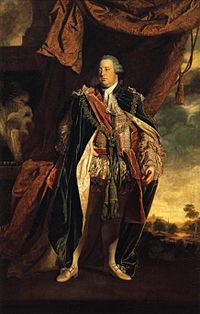
In 1754, Britain and France started fighting over land in North America. France built many forts in the Ohio Valley. The British government first planned a small military response. William thought this plan was not strong enough. He expanded the plan to include four attacks on New France at the same time.
William believed only a very strong force could defeat France in America. He also suggested a commander-in-chief for forces in America. This person would raise local troops and lead strategy. Two regiments from Ireland were sent for this. William chose Edward Braddock, an officer he liked, to lead all British forces in America. This surprised many because Braddock was not well-known.
The bolder plan was approved, but it had limited success. William advised on the war in North America. He thought the colonies should do most of the fighting. Regular troops should only help. He helped appoint Loudoun, another favorite officer. William advised Loudoun to let his officers and soldiers go on scouting trips. This would help them "learn to beat the woods." William also approved creating light infantry in the British Army.
Defending Hanover
In 1757, the war spread to Continental Europe. William was put in charge of the Hanoverian Army of Observation. This army was meant to defend Hanover from a French invasion. Hanover was a German state ruled by King George II.
At the Battle of Hastenbeck, near Hamelin, on July 26, 1757, William's army was defeated. The French forces were stronger. William's army began to retreat. Soon, discipline broke down, and his army fled in disorder. William hoped the Royal Navy would send him help. But the British sent an attack force to Rochefort instead.
By September 1757, William and his forces had retreated to the town of Stade on the North Sea coast. King George II gave him permission to make a separate peace deal. William was surrounded by French forces. He agreed to the Convention of Klosterzeven on September 8, 1757. Under this agreement, his army would be disbanded, and much of Hanover would be taken by the French.
When William returned to London, his father treated him badly. King George II said, "Here is my son who has ruined me and disgraced himself." In response, William resigned from all his military and public jobs. He retired from public life.
Final Years
William spent his final years during the reign of his nephew, George III. George III became king after William's father died in 1760. William became an important advisor to the King. He helped set up the First Rockingham Ministry. Meetings were held at his homes in Windsor or London.
William never fully recovered from his leg wound from the Battle of Dettingen. He was also very overweight. In August 1760, he had a stroke. On October 31, 1765, he died at his London home at age 44. He was buried in Westminster Abbey. He never married.
Legacy
Several places in the American colonies were named after him. These include Prince William County, Virginia, Cumberland County, Maine, Cumberland County, New Jersey, Cumberland County, North Carolina, and Cumberland County, Virginia. Also, the Cumberland River, the Cumberland Gap, and the Cumberland Mountains bear his name. In Britain, Cumberland Road in Kew and Cumberland Gate into Kew Gardens are named after him.
In 2005, BBC History Magazine named him the 18th century's worst Briton.
A tall monument called an obelisk was built in Windsor Great Park to honor William's military service. It says: "THIS OBELISK RAISED BY COMMAND OF KING GEORGE THE SECOND COMMEMORATES THE SERVICES OF HIS SON WILLIAM DUKE OF CUMBERLAND THE SUCCESS OF HIS ARMS AND THE GRATITUDE OF HIS FATHER THIS TABLET WAS INSCRIBED BY HIS MAJESTY KING WILLIAM THE FOURTH". A local guide says it originally said "Culloden," but Queen Victoria had that word removed.
A statue of William on horseback was put up in London's Cavendish Square in 1770. But it was removed in 1868. By then, people generally disliked the "butcher of Culloden." The original base of the statue remains.
Images for kids
-
Jacobite broadside - François Morellon la Cave, Effigies sculpt.


